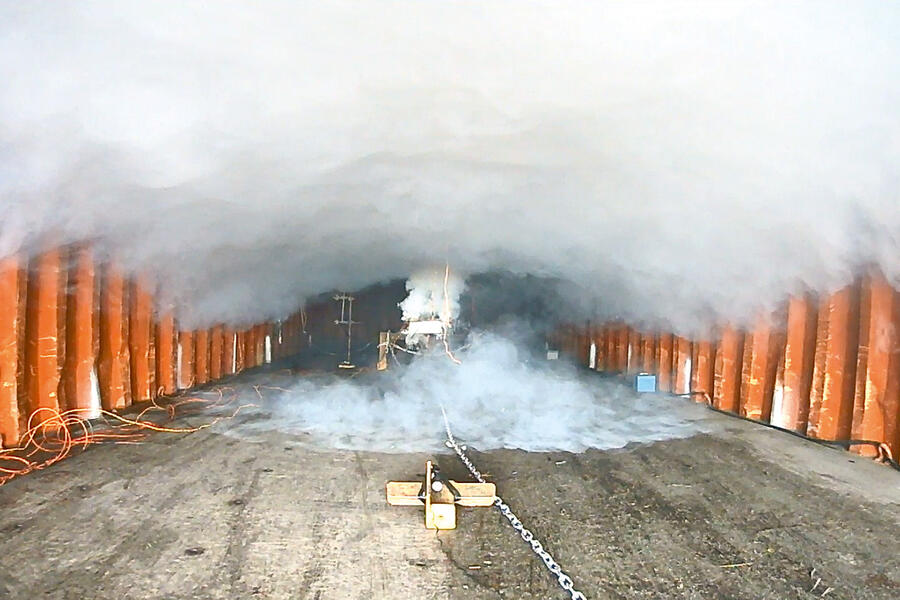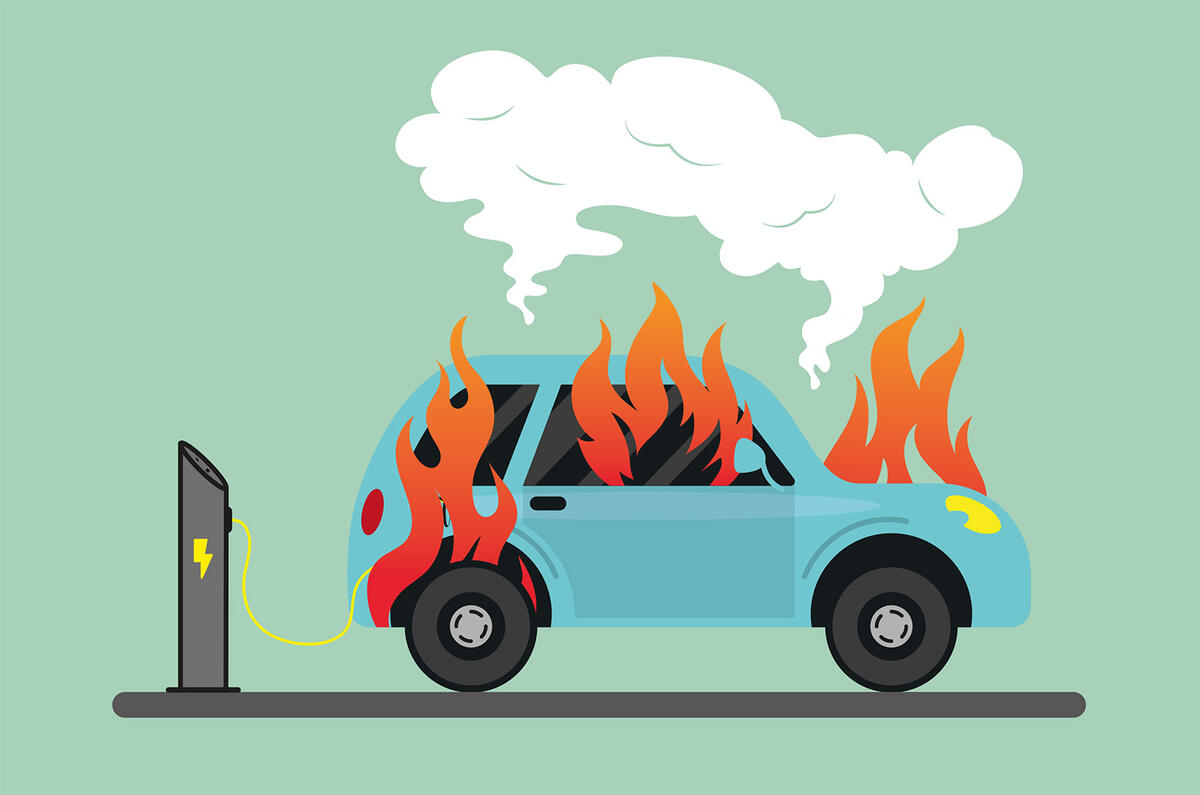As the prominence of electric cars on UK roads rapidly grows, more attention is turning to any potential safety concerns that such new technology presents.
One of the major concerns presented by the introduction of electric cars is the risk of fire - or, rather, the perceived risk of fires involving electric cars.
Petrol and diesel cars still catch fire (remember the spate of Vauxhall Zafira fires not so long ago?), but given how recently electric vehicles were introduced, they make the news far more often, and sometimes unfairly.
As the world gets used to this kind of technology and protocols are put in place to safeguard against disasters (for example, ship owners are increasingly being told to protect their vessels against car fires), it's worth getting to grips with the statistics, why these fires command so much attention, how fire crews deal with them and what it means for you.
Are electric car fires common?
EV fires aren't a common occurrence. In fact, data gathered over the last few years suggests EV fires are a lot more rare than internal combustion fires.
According to the Authority for Social Protection and Preparedness in Sweden, of the average 3400 vehicle fires that occur each year in the country, just 0.4% of them are electric cars, and 1.5% are hybrid cars.
Per the London Assembly and the Greater London Authority, 2023 saw 493 petrol cars catch fire, compared to 138 diesel cars and just 7 battery electric cars.
According to Honeywell Safety and Productivity Solutions, 239 fires recorded in the UK from July 2022 to June 2023 were linked to EVs. While this is an 83% increase year on year, it’s important to note the number has increased along with the increasing presence of EVs on our roads.
Meanwhile, according to Bedfordshire Fire and Rescue Service, some 1898 fires in the county in 2019 were from petrol and diesel vehicles. Just 54 were from EVs.
Another study by the Swedish Civil Contingencies Agency found that EVs are 20 times less likely to catch fire than ICE cars.
An additional study by that agency and an American insurer found that just 25 out of 100,000 EVs suffer fire damage.
By comparison, 1530 per 100,000 ICE cars experience fire, and hybrid vehicles suffer a much higher risk of 3475 per 100,000.
Why do electric car fires command so much attention?
Electric car fires draw increased attention for many reasons. Firstly, the technology is new and newsworthy.
That said, the real problem with electric car fires is they're remarkably difficult to extinguish due to their complex chemistry, which utilises a large lithium-ion battery.
Thermal runaway occurs when an EV battery catches fire, where a battery cell short circuits and warms up to dangerous levels. This can lead to a sort of domino effect, meaning other cells in the battery pack undergo the same process.
According to Bedfordshire Fire and Rescue Service, over 100 organic chemicals are generated in an electric vehicle fire. Some of the gases are seriously toxic, specifically hydrogen cyanide and carbon monoxide.
They also burn extremely hot and are difficult to cool. Australia-based EV Firesafe suggests it can take upwards of 10,000 litres of water to extinguish an EV fire.
Electric car fires are tough to extinguish because it's often difficult to access the battery and get cool water onto the problem cell. You think it’s out, and then it erupts again hours, days or even weeks later.
All this considered, it’s no wonder people are becoming concerned about electric car fires, not least those who have to put them out.
How fire crews deal with EV fires
Fire services are developing new strategies to deal with electric car fires.
Bedfordshire Fire and Rescue Service, for example, has announced that in the aftermath of any incident, road-traffic collision or fire involving an EV, “one of our attending fire engines will follow the recovery vehicle back to the unloading point at their yard to assist with any fires”.
It also said it has developed a system that enables fire crews to identify what model of EV is involved in an incident and where its battery and isolation switches are.

Experts are divided on how best to tackle an EV fire but, generally, immense quantities of water to cool the battery pack (although this won’t prevent fire erupting again), a fire blanket to suppress the flames and breathing equipment for the firefighters to protect them from the toxic vapour cloud is the standard approach. Either that or simply let the blaze burn itself out.
Attempting to suffocate the fire with inert gases is ineffective because, being a chemical blaze, it doesn't require oxygen. Meanwhile, the surrounding area must be checked for discarded battery cells that could have been propelled from the battery pack by an explosion and might spontaneously ignite later.
Following containment, the burnt-out EV must be removed and deposited in a compound away from buildings and other vehicles. (Some 25% of scrapyard fires are caused by spent lithium ion batteries.)
More radical steps include immersing the car in water, although not sea water, because chlorine gas could be released.
Does the fire risk mean electric cars are unsafe?
It all sounds quite alarming and a good reason not to buy an electric car, but Paul Christensen, professor of pure and applied electrochemistry at Newcastle University and senior advisor to the National Fire Chiefs Council, is keen to quell fears about EV fire safety, especially given the benefits the technology offers.
“As someone who assisted Nissan during the creation of its battery plant, I would, if I could afford one, have a Nissan Leaf tomorrow,” he says. “We don’t need to be worried about the small incidence of fires involving electric vehicles but we do need to be aware.
"A lithium ion battery stores a huge amount of energy in a very small space. Since 2008, the adoption of such batteries has outstripped our appreciation of their risks. We’re running to catch up, but we will do.”
As part of his campaign to improve EV fire risk awareness among first responders, Christensen has so far presented to 30 of the UK’s 50 fire services, as well as to fire services in Europe, Australia and New Zealand.
He begins each talk by describing the structure of a lithium ion battery cell. A sliver of aluminium, called the cathode, is coated with a mixed-metal oxide ink.
It’s partnered by a slice of copper coated with graphite called the anode. In between them is a fragile, perforated plastic separator soaked in an organic solvent that contains a small quantity of additives whose identity is, troublingly, known only to the cell manufacturer.
Depending on whether the battery is being charged or discharged, the lithium ions move either from or to the cathode and anode.

Then the professor gives his audience of firefighters their first shock. Full, a cell contains 4.2V of charge, but even when empty, it still holds 2.5V. A Nissan Leaf has from around 192 cells in 24 modules and a Tesla Model S more than 7000 in 16 modules. That’s a lot of energy when the car’s power indicator says it has none.
Full or ‘empty’, the risk of this energy escaping in an uncontrolled fashion is what some scientists believe leads to ‘thermal runaway’, when heat and gases fuel even higher temperatures and still more gases, including hydrogen and oxygen, in a self-fulfilling loop until the cells begin to burn and burst.
A toxic vapour cloud develops, bringing with it the risk of deflagration. Once thermal runaway has started, no battery management system or circuit breaker can stop it.
“A battery fire can be controlled but it cannot be extinguished,” says Christensen.
He has demonstrated in tests how perforating or otherwise damaging a battery pack, as in a crash, can cause it to catch fire. "If an EV’s battery case is dented, you have to assume it’s dangerous,” he says.
Battery packs have been known to catch fire through overheating and while being charged. More worrying, a battery fire can erupt spontaneously, contamination of even just a single cell during its manufacture being one possible explanation.
“Even the most experienced and careful manufacturers have defective electric cells passing through their very careful quality control systems,” says Christensen.
A battery flame is like a blowtorch that will quickly ignite anything in its path, which is why Christensen wants councils and other organisations to consider EV safety risks in underground car parks, as well as bus depots where vehicles are parked side by side.
“In Germany, three bus depots have gone up in flames in the past six or so months,” he says. “Tunnels, ferries, car parks, cargo ships transporting EVs – all the places you find electric vehicles should be considered a safety risk and the appropriate steps taken.”
He’s worried about classic cars being converted to run on used lithium ion batteries, too. “Nobody really knows how safe used lithium ion batteries are and no standard test has yet been devised to tell us,” he says.
“Some batteries re-enter the market having been removed in illegal chop shops. How safe are they? There’s a lot of research into lithium ion battery safety, but everyone needs to link up, because right now we’re at the bottom of a very steep learning curve.”

When all else fails…
For electric cars that are on fire or at risk of being so, the fire service in Copenhagen, Denmark, has developed a truck-mounted vehicle containment solution, pictured above.
The smouldering EV is lowered into the container, which, like a skip, is then hoisted onto a flatbed truck. Nozzles in the floor and sides of the container allow water to be pumped into it. Once full, the container and car are taken to a safe storage area and left, possibly for weeks, until the vehicle is no longer a hazard. All being well, the water is then filtered and treated for safe disposal.






Join the debate
Add your comment
"Meanwhile, according to Bedfordshire Fire and Rescue Service, some 1898 fires in the county in 2019 were from petrol and diesel vehicles. Just 54 were from EVs."
A meaningless statement. How many EVs in Bedfordshire in 2019 vs how many petrol and diesel? What if there were only 54 EVs in Bedfordshire?
I'm sure that a professor of pure and applied electrochemistry at Newcastle University and senior advisor to the National Fire Chiefs Councilure could afford a Nissan Leaf, even a used one?
Professors are wise people and the respected Newcasle University professor understand econimics. He says that he is not rich enough to afford a cheap car, in order to prevent Her Majesty’s Revenue and Customs officers to pay him a visit.
understans economics.
Sorry for the errors, I wrote in a hurry, running away from HMRC officers.
I guess you are not familiar with academic salaries, then - his implication that he couldn't afford one is entirely plausible. I co-authored 150 modern languages text books, including the best-selling schools French text book in history, and I certainly couldn't afford one. Professors, like nurses and teachers, are scandalously underpaid.
Understanding Cell chemistry is the key to understanding Thermal Runaway. I'm working with a small start-up called Nanoz that has a very unique way of detecting unstable battery cells or cells beginning the early stage of TR long before a fire becomes an issue. It has an ability to seek out individual molecules of leaking cell gases, which it can identify a gas or gases associated with Thermal Runaway and raise the alarm. This has never previously been possible. This could potentially end all possibilitiy of a EV or battery fire.